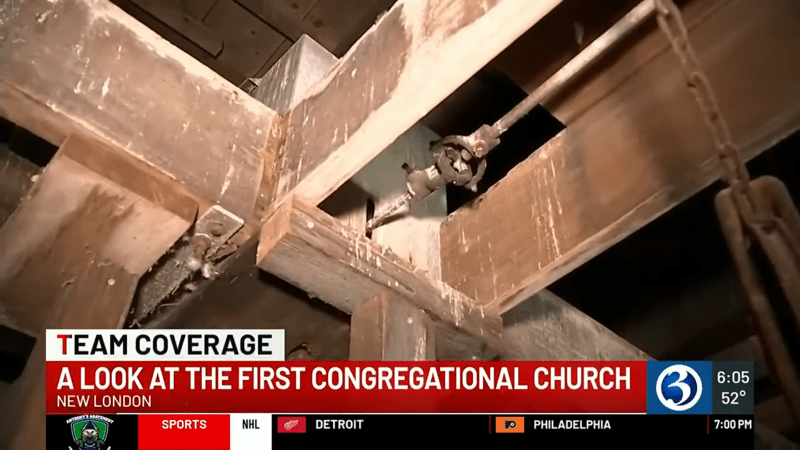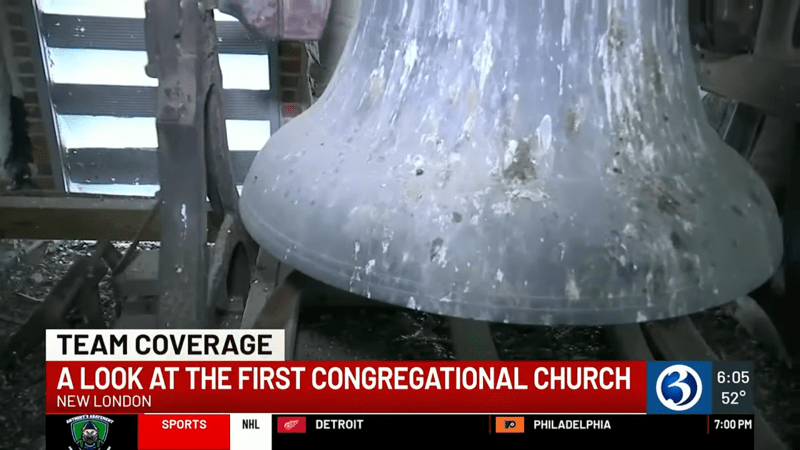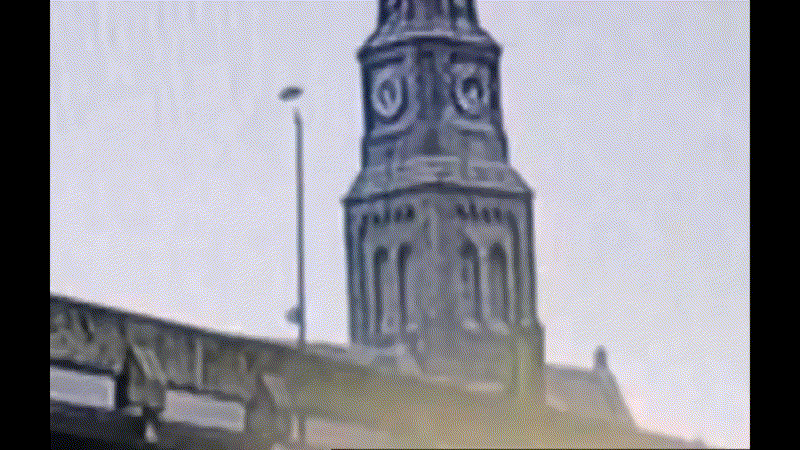Navigation
Install the app
How to install the app on iOS
Follow along with the video below to see how to install our site as a web app on your home screen.
Note: This feature may not be available in some browsers.
More options
Style variation
-
Congratulations cowski on being selected by the Eng-Tips community for having the most helpful posts in the forums last week. Way to Go!
You are using an out of date browser. It may not display this or other websites correctly.
You should upgrade or use an alternative browser.
You should upgrade or use an alternative browser.
Church Steeple collapse, New London CT 11
- Thread starter GPR_Tech
- Start date
- Status
- Not open for further replies.
- Thread starter
- #42
Several suppositions from the video that are simply wrong, show a lack of understanding of how masonry works (poor mortar causes compressive collapse), etc.
I like his use of graphics to observe the lean in various photos but he would do better to build his commentary and then have an editor (an engineer) review it for stupidity).
I like his use of graphics to observe the lean in various photos but he would do better to build his commentary and then have an editor (an engineer) review it for stupidity).
LittleInch
Petroleum
The complete lack of pictures that I've looked for of what the inside of the tower / steeple looked like is a big gap in our understanding of the condition of the visible brickwork.
It seems pretty inconceivable that there wasn't something amiss inside the building for it to suffer a blow out type event.
So maybe those rods finally failed, or someone decided to remove one because it was "in the way" or just there were not enough of them to hold the stonework together.
Probably never know and my guess is that the evidence will be trucked away pretty fast.
Remember - More details = better answers
Also: If you get a response it's polite to respond to it.
It seems pretty inconceivable that there wasn't something amiss inside the building for it to suffer a blow out type event.
So maybe those rods finally failed, or someone decided to remove one because it was "in the way" or just there were not enough of them to hold the stonework together.
Probably never know and my guess is that the evidence will be trucked away pretty fast.
Remember - More details = better answers
Also: If you get a response it's polite to respond to it.
Jeff did miss the subtlety that Sym P. le did not - the slippage in the arch windows on either side of the spire.
There is a relatively small amount of stone retaining the sides of the inside arch. It could have been as simple as one of the small window arches giving way and letting the main arch go that brought it all down. Note that the steeple had an initial fall towards the same side as the small window with the larger displacement. This is also where the buttress had the least weight on the window arch.
There is a relatively small amount of stone retaining the sides of the inside arch. It could have been as simple as one of the small window arches giving way and letting the main arch go that brought it all down. Note that the steeple had an initial fall towards the same side as the small window with the larger displacement. This is also where the buttress had the least weight on the window arch.
LittleInch
Petroleum
The spire didn't just "topple" though. It appears as though it blew out initially in the lower stage somewhere, fell vertically for a while, then toppled over.
Quite amazing that the other two towers were seemingly unaffected.
Remember - More details = better answers
Also: If you get a response it's polite to respond to it.
Quite amazing that the other two towers were seemingly unaffected.
Remember - More details = better answers
Also: If you get a response it's polite to respond to it.
They likely weren't impacted and they are relatively short and very stiff. I'm not too surprised. It would be great to have drawings of the church as well as the early architect's letter and the latter architect's report as well as any inspection reports. Would this be an insurance claim? Do they need to leave the rubble until the insurance company does a report?
-----*****-----
So strange to see the singularity approaching while the entire planet is rapidly turning into a hellscape. -John Coates
-Dik
Murph 9000
Computer
There's a pretty big knowledge gap in understanding the structure of the spire right now. We don't know much about the interior structure on the vertical plane where the spire met the main roof (i.e. the lower north side of the spire). There was likely some form of arch there, at least as big as the main exterior door arch on the south side. If there was a pair of column-type structures there on the north side (similar to the two southern corners of the central tower), the initial failure may be the northwest lower column of the tower, with the roof level buttresses being more for lateral support than vertical support.
I spent a while trying to find interior photos which might show some detail looking south towards the central tower, but didn't find anything useful. I was searching based on "First Church of Christ", "First Congregational Church" and "Engaging Heaven Church"; the first two terms match a lot of different churches, and Google's image search engine doesn't seem particularly good at narrowing it down to just the New London church.
I spent a while trying to find interior photos which might show some detail looking south towards the central tower, but didn't find anything useful. I was searching based on "First Church of Christ", "First Congregational Church" and "Engaging Heaven Church"; the first two terms match a lot of different churches, and Google's image search engine doesn't seem particularly good at narrowing it down to just the New London church.
Jeff Ostroff
Electrical
The Isaac Middle School behind the church has geometry students looking at previous days of video from their security camera and they have already noticed that the lean angle of the steeple increased 2 degrees just from Jan 15 until the day of the collapse. They plan to turn over their analysis to the city next week.
-
1
- #55
Jeff Ostroff
Electrical
From 2011 inspection by structural engineers: The exterior tower wall, originally constructed as a two-wythe cavity wall, was grouted solid during the most recent renovations in the mid-nineties. Prior to this renovation, the same tower wall was reinforced from the inside with steel tie rods to prevent the walls from parting.
These corrective actions appear effective, as by all visible accounts, the tower is structurally sound.
The remaining granite walls appear to be sound as well, with the only area of concern being a small stress fracture running through the mortar joints in the northeastern wall (Figure 09). Fractures like this can occur from slight movement in the wall caused by settlement, spalling, or impact. This fracture is more cosmetic than anything and should be remediated by repointing the mortar joint.
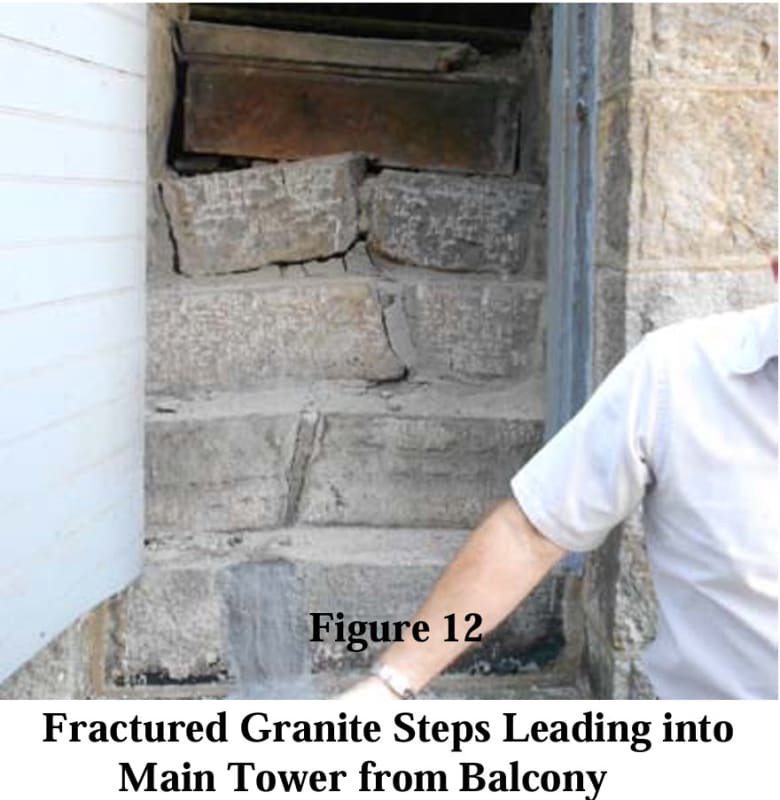
And also this one
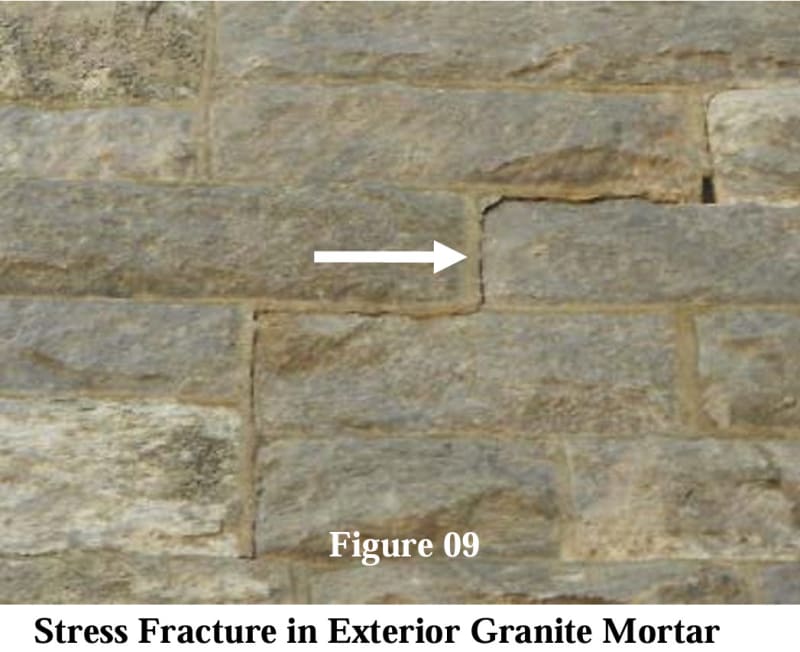
These corrective actions appear effective, as by all visible accounts, the tower is structurally sound.
The remaining granite walls appear to be sound as well, with the only area of concern being a small stress fracture running through the mortar joints in the northeastern wall (Figure 09). Fractures like this can occur from slight movement in the wall caused by settlement, spalling, or impact. This fracture is more cosmetic than anything and should be remediated by repointing the mortar joint.

And also this one

Jeff Ostroff (Electrical) 1 Feb 24 04:05 said:Fractured Granite Steps
This is about as clear an indication of a masonry arch failure (
City of New London - related Documents site
LittleInch
Petroleum
Jeff Ostrod said:From 2011 inspection by structural engineers:
Jeff, do you have a copy or a link to it as I've never seen it, only heard about it and those cracked step photos look very interesting.
To be fair to the surveyors / engineers, it does look like something only started moving in the last few weeks / months to be visible to the naked eye.
It was a fairly slender tower, but shows the issue about " well its stood there for 170 yrs" being not always worth what it seems.
Catastrophic collapse rarely happens without some sort of warning, the issue is whether that warning was acted upon and whether it was reasonable for someone to act on it. I'm beginning to wonder if one of those tie rods which look fairly weedy and not many of them just gave way / snapped and hence the things literally holding the building together failed and initiated the collapse due to some sort of settlement. Or if they failed and then the building started moving.
Remember - More details = better answers
Also: If you get a response it's polite to respond to it.
Inspection report attached below or linked here - [URL unfurl="true"]https://newlondonct.org/filestorage/7495/7518/7623/37687/New_London_First_Congregational_Church_-_Conditions_Report_2011.pdf[/url]
- Status
- Not open for further replies.
Similar threads
- Replies
- 13
- Views
- 13K
- Replies
- 61
- Views
- 3K
- Replies
- 8
- Views
- 6K
- Replies
- 1
- Views
- 648
- Replies
- 46
- Views
- 7K

![[lol] [lol] [lol]](/data/assets/smilies/lol.gif)
